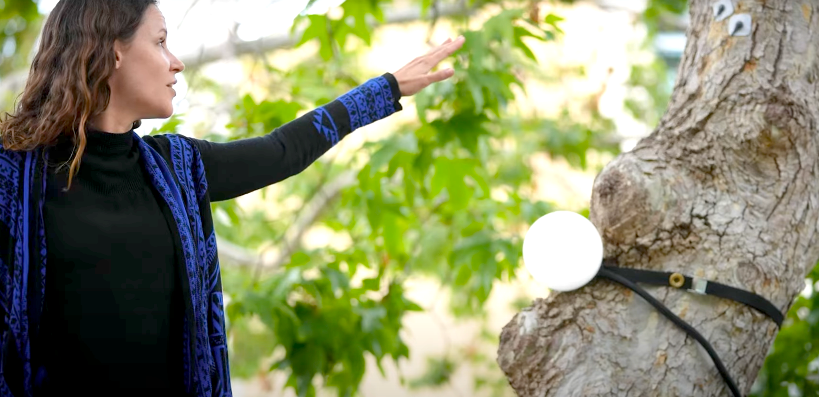
(Sun Eaters, From IDEAS performance @ Qualcomm Institute)
The Rhythm that Flows Through Us All:
Grace Grothaus’ Sun Eaters
Interviewer: Olivia Ann Carye Hallstein
Grace Grothaus creates immersive environments using computational media revolving around subjects related to the global climate crisis. Finding incredible intersections between technologies and the environment, she uses computational methods to aid the visualization and understanding of human impacts. In her recent work Sun Eaters, Grace has rewired ECG sensors to translate the electrical currents in trees into light. Similar to the human heartbeat, the trees express the pulses that give them life through the light that is presented. For the first time, the viewer can experience the life force in the surrounding plant life as part of the rhythm that flows through all of us.
Hi Grace! Thank you so much for taking the time for this interview. It is so exciting to learn about your work!
Though your work is vast, and you have created incredible installations that encourage viewers to focus on the larger world around them, we will mostly be focusing on your piece Sun Eaters for this interview in correlation with ecoartspace’s focus on trees the last year. Can you start out by speaking a bit about your art practice and goals?
As an artist working in computational media on issues arising from the global climate crisis, I focus increasingly on environmental sensing and visualization to open up conversations through public artworks. My projects generally take the form of interactive or responsive installations, though at times, I also make artwork through video, prints, and sculpture.
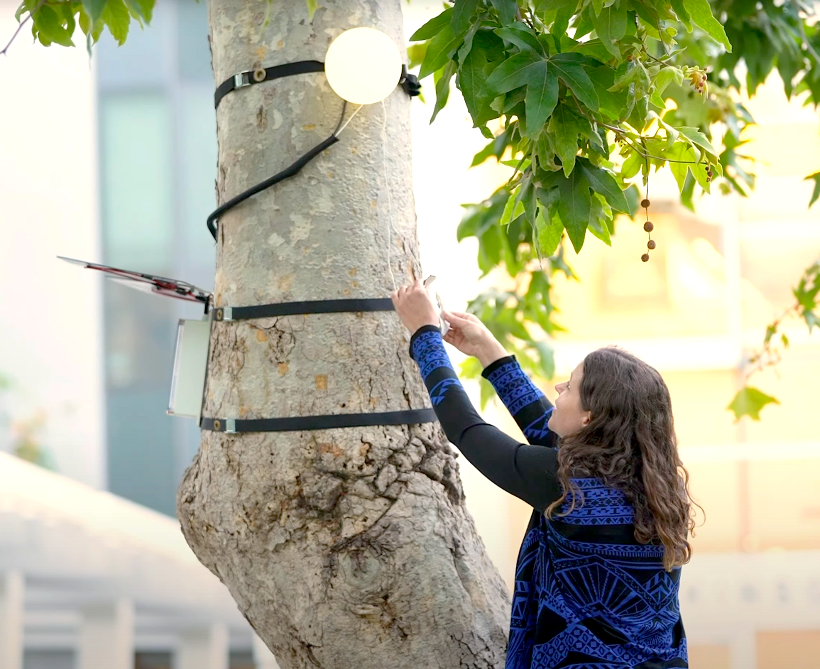
(Sun Eaters, From IDEAS performance @ Qualcomm Institute)
Plants are more similar to ourselves than perhaps we commonly give credit.
Sun Eaters is an installation of sculptures that senses bioelectric energy and translates it into visible light for us to see by using ECG sensors. In Sun Eaters, I have focused specifically on measuring and visualizing bioelectricity in plants to call attention to them. Sun Eaters has been installed in a number of venues along paths where people frequently walk and the sculptures’ flickering lights can be seen. For much the same reasons that some stop signs and warning notices are outfitted with blinking LEDs, I’ve illuminated these trees with the same: to arrest your attention within our over-saturated world. The brightness of the lights in Sun Eaters is in direct correlation to the bioelectric pulse of the plant it is measuring. I hope that people will see that plants are more similar to ourselves than perhaps we commonly give credit. They begin to pay more attention to the more-than-human living ecosystems present around them in their daily lives.
Plant blindness, a form of cognitive bias, is a common tendency to overlook plants and to treat them solely as a beautiful backdrop in front of which human action takes place. Yet plants trees, particularly, sequester large amounts of atmospheric carbon, and we need them to counteract our warming climate. For this reason and others, trees are vital to the health of our future and worthy of our increased attention. I believe that Sun Eaters can play a role in environmental efforts by acting as a visual aid in comprehension, and I hope that the project might trigger an expansion of our imagination: to consider the lives of plant beings of the world to be as worthy of attention and care as our own. Maybe Sun Eaters can provide an empirical interface for grasping ecological processes and ways of thinking about them?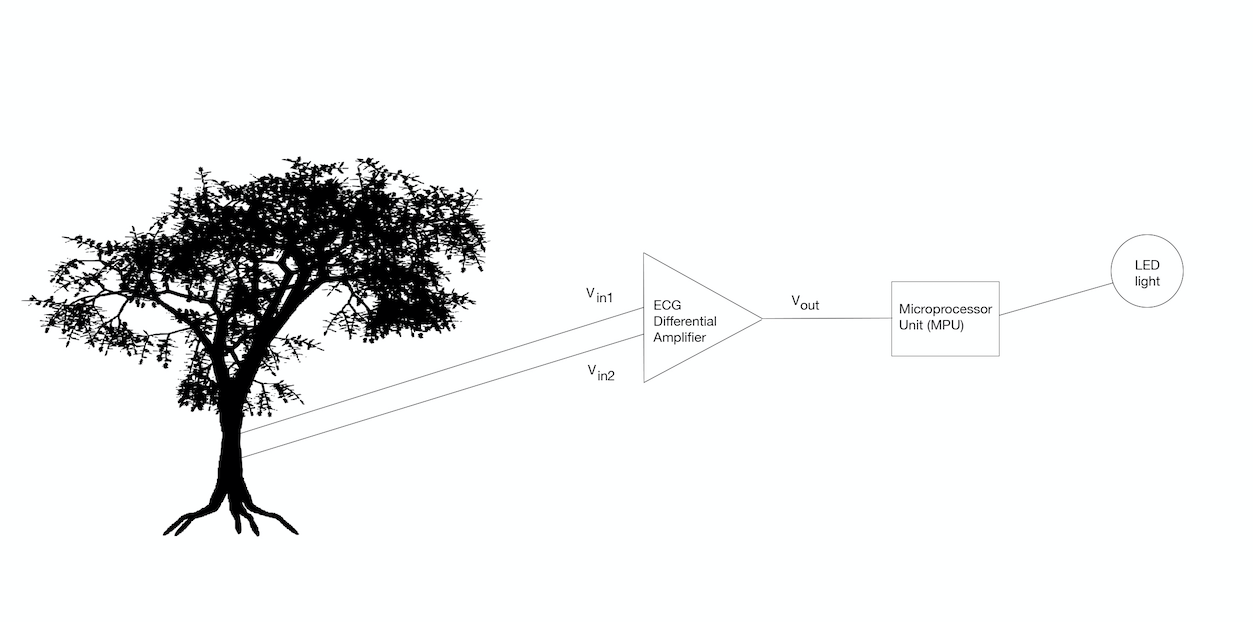
Seeing aids believing. Vision is our most important sense for perceiving and interacting with the surrounding world in terms of our attention.
What a beautiful goal! By visualizing the bioelectric currents in trees, you are presenting something otherwise invisible. What role does making the invisible visible feature in your art practice? Why do you think this is important?
I’m motivated by the understanding that seeing aids believing. Vision is our most important sense for perceiving and interacting with the surrounding world in terms of our attention. There are more neurons in our brains firing for the purpose of comprehending what we see than any of our other senses. At one time, microscopes awakened us to a microbial world. Maybe visualization of other invisible aspects of our fragile earth ecosystems will help us understand them better and subsequently take better care of them? It’s a question that I think is worth exploring.
And Sun Eaters is a wonderful example of presenting that visualization. Can you explain a little about the process of creating Sun Eaters? What were your main takeaways from the experience?
I was researching about recent scientific developments in our understanding of plants as being able to do things such as learn, count, and share resources with one another via collaboration with mycorrhizal networks, and I came across artworks from the 1970s in the United States where people were using sensors to generate live music from plants. I started to experiment in my studio and became very excited by realizing I could effectively use ECG sensors to generate not music but light. Higher levels of bioelectric energy I translated to brighter light and lower levels to more dim light. It felt incredible to be able to watch the plants in my studio garden in this way. It felt like I was better connected with the plants, like the rudimentary beginnings of understanding plant ontologies better. My mind caught fire, and I wanted to go further with this. What more could I learn through such experimentations?
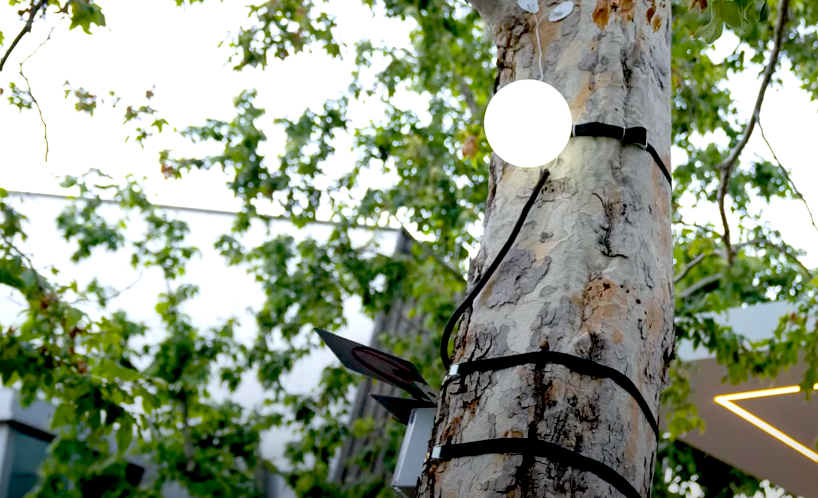
(Sun Eaters, From IDEAS performance @ Qualcomm Institute)
What an incredible connection to music! While describing your Sun Eaters project, you also discuss the rhythm of the natural world and how we are a part of it. Can you talk about your experience in the Mata Atlantica Forest in South America and the insights you gained from spending time there?
When living in cities (which a majority of humans now are, for a majority of our time), we aren’t linked as closely to circadian rhythm cues. For parts of last year and this, I was spent time living well outside the city in the Mata Atlantica. I not only felt my own being tuned more closely to the daily cycle of sunrise and fall, but I also witnessed the other plants and animals do the same. Birds and monkeys and all manner of animals make noises daily during what is often called the dawn and dusk chorus. In fact, I recently learned that oceanographers have found that even fish are noisiest at dawn and dusk (it takes special microphones to hear it, though, which is why we didn’t know before). I enjoy thinking of it as an ongoing daily song that all living beings are participating in together. Perhaps I, as a human, need to connect consciously, and because as I am not living indigenously, I seem to forget.
This topic of consciously connecting to the environment reminds me of an ever-diminishing attention span attributed to the twenty-first Century. You have even discussed climate change as “something happening on a scale that is not at a human attention span” and has produced work about that difference in time experience. Can you talk about this gap?
That is an interesting question. Weather changes within the human attention span. and climate is a slower, intergenerational process. However, this is all changing. With our near exponentially accelerating storm patterns, rainfall changes, and ever hotter summers, we are beginning to see climate change within our attention span. But as for perceptual gaps, I think it is closely related to the importance of visualizing the invisible. How can and how does visualization help us to comprehend our world? These are important questions for me in the studio.
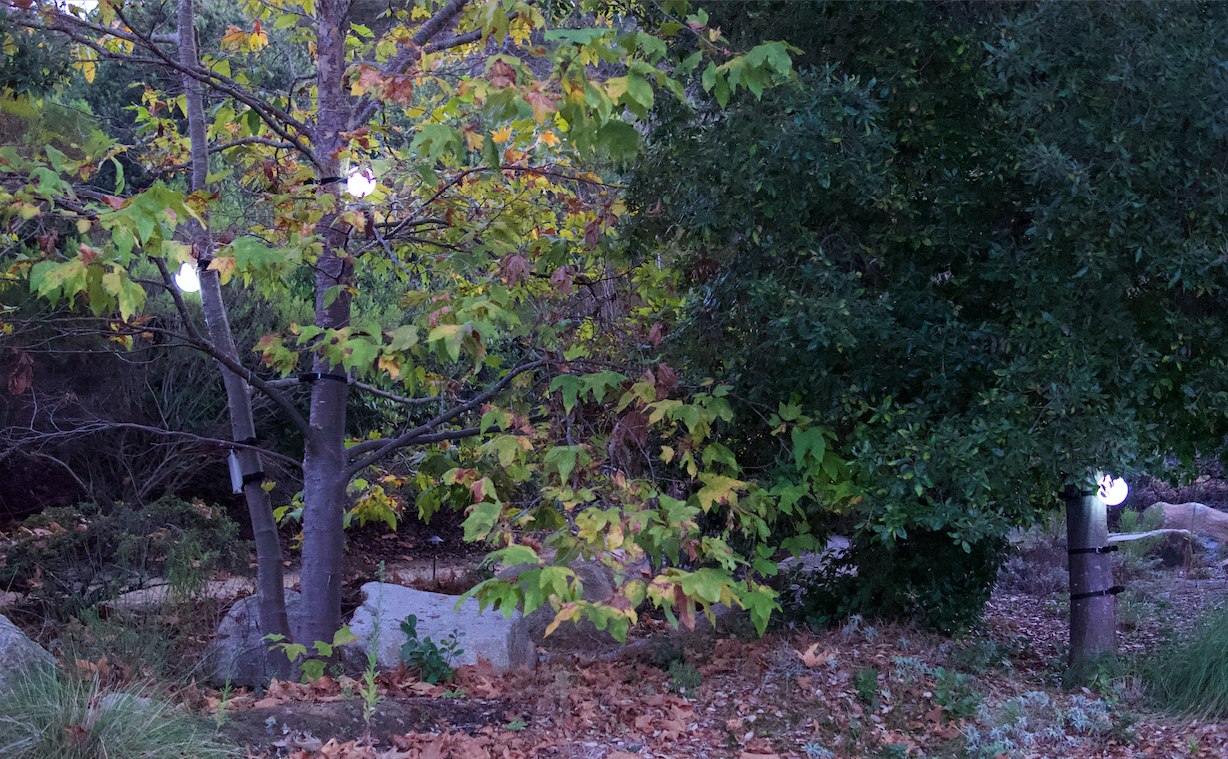
Now is not the time to give up but to do everything we can to reach zero emissions and create a just and equitable world for everyone: every person and every species.
Absolutely! This summer has been such a pervasive and undeniable reminder that climate change is present and has been underscored further in the recent AR6 Climate Change 2021 IPCC report. What have you noticed in your communities, and how will the experiences of this summer influence the nature of your art practice?
Yes, this latest IPCC report is an even more explicit and grave warning of what is to come. Hardly a day goes by that I don’t think about this, and the alarm bells are going off louder and louder as we witness the horrific evidence of the changes we have wrought to the climate, such as this summer’s fires and heatwaves. I often think that well before I was born people were awakened to the realization that the climate was changing, yet policies and politics did not change. Now it is 2021, and I am hoping that swift action is beginning to occur, and I think it is. Indeed this is the greatest threat humanity has faced, but conversely, it is our greatest opportunity to create positive change. Now is not the time to give up but to do everything we can to reach zero emissions and create a just and equitable world for everyone: every person and every species. It is a global ecosystem, everything is interconnected, and each is necessary to all the others.
In my communities of artists and environmentalists and people in various places that I have lived in my life, I hear an increase in openness to discussing the climate crisis and an upswell in commitment to make personal and system(s)-wide changes and thankfully, I hear one thing less and less: uncertainty that the climate is changing due to human action.
What a call to action! Sun Eaters seems like a project that sits at an intersection of art, research, and experimentation. How do art and science feed off each other? What do you think that art can do that science cannot in these topics?
These are very interesting questions to me. What are the boundaries between disciplines? Is science an endeavor of making discoveries? Is it new knowledge production? Are the arts conversely about reminding ourselves of timeless truths? Could an artist make art using the scientific method? Can scientists do research that includes emotions in their consideration? It’s clear that the distinctions are not clear cut, and generally, the answers are “it depends.” I’m interested in working horizontally with people across disciplines if the collaboration can mutually make possible things that wouldn’t be possible otherwise, and it is often the case. It is a very exciting space to explore.
At a very young age, I made sculptures when I was learning about the Keeling Curve. Then I began making work it and about speculative futures. I also started wanting my sculptural work to be and do more, so I integrated electronics into my work. The fundamental framework of electronics is that you use inputs such as sensors, process the signal(s), and then output them through different things such as light and motion. At some point, I realized that this provides the possibility for not just making work about our environmental present or potential futures but also actually and specifically measuring our environments. I’m excited about where this line of inquiry is leading. Can my artwork do more and be more active; can my artwork itself act and have activist agency in the world? What will it take for Earth to reach zero emissions and create a more just and equitable world in the process? In what ways can I best contribute my individual skills towards this global, collective effort?
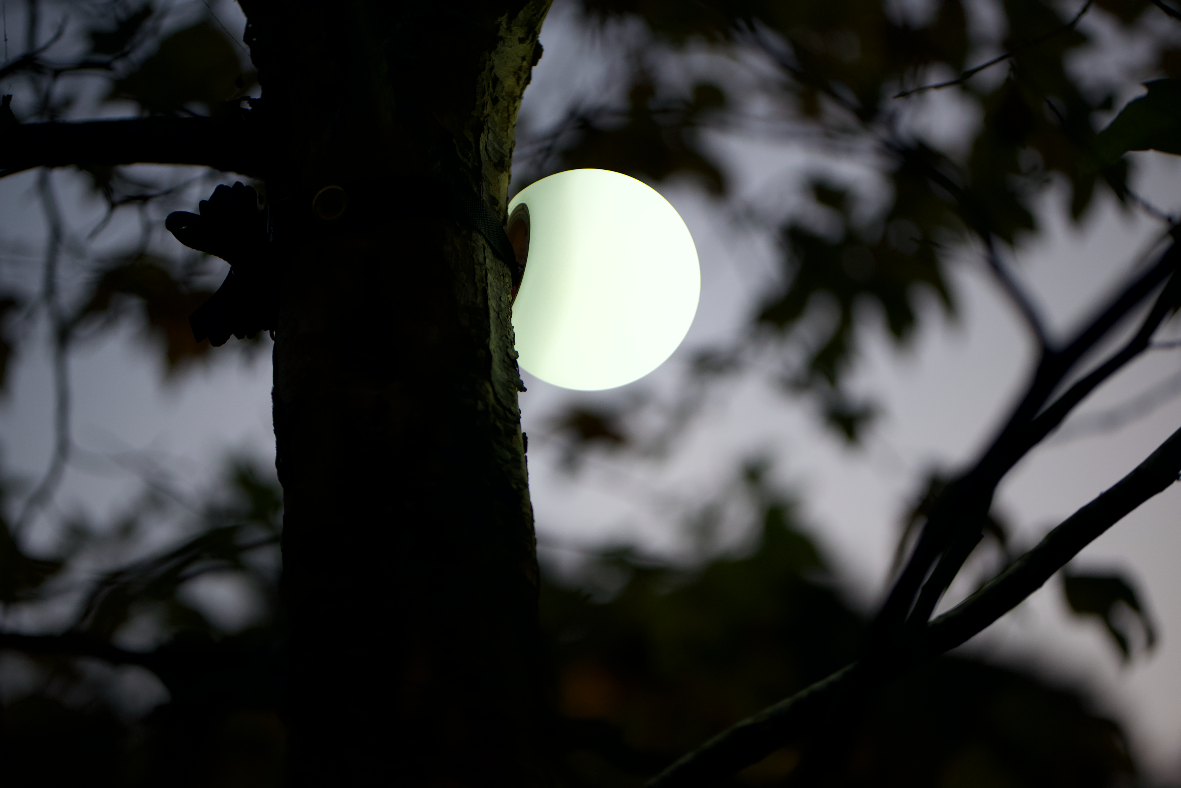
Can my artwork itself act and have activist agency in the world?
What new work(s) are you developing right now? You will be starting a Ph.D. in Digital Media at York University in Toronto. Can you talk about your research direction and what you see as your next steps?
Next month I begin a Ph.D. program in Digital Media at York University. There I will be able to expand on the work started with Sun Eaters and new work that I am eager to develop regarding visualization of air pollution. At this time, that is all I can say about this new work, but I look forward to sharing more with you in the coming months and years.
Thank you very much for this opportunity to share a few of the ideas that fuel my artistic practice, and thank you for the support and community you foster for all of us involved with ecoartspace!
Thank you, Grace, for continuing your incredible work!
Sun Eater's online Performance on YouTube